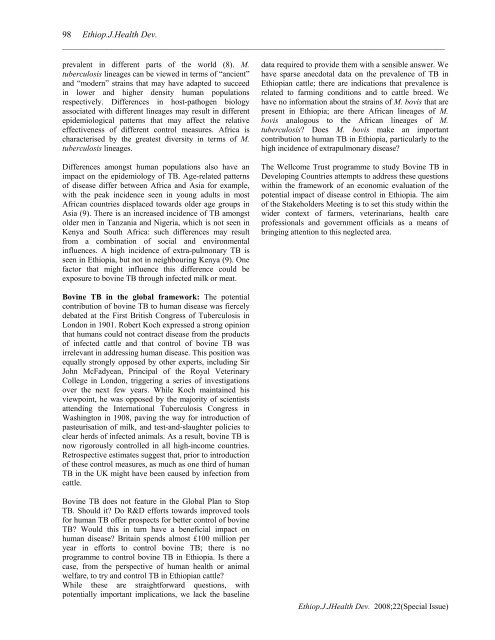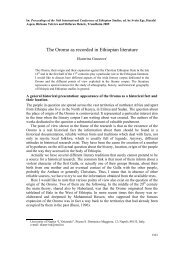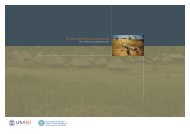Create successful ePaper yourself
Turn your PDF publications into a flip-book with our unique Google optimized e-Paper software.
98 Ethiop.J.Health Dev.<br />
______________________________________________________________________________________<br />
prevalent in different parts of the world (8). M.<br />
tuberculosis lineages can be viewed in terms of “ancient”<br />
and “modern” strains that may have adapted to succeed<br />
in lower and higher density human populations<br />
respectively. Differences in host-pathogen biology<br />
associated with different lineages may result in different<br />
epidemiological patterns that may affect the relative<br />
effectiveness of different control measures. Africa is<br />
characterised by the greatest diversity in terms of M.<br />
tuberculosis lineages.<br />
Differences amongst human populations also have an<br />
impact on the epidemiology of TB. Age-related patterns<br />
of disease differ between Africa and Asia for example,<br />
with the peak incidence seen in young adults in most<br />
African countries displaced towards older age groups in<br />
Asia (9). There is an increased incidence of TB amongst<br />
older men in Tanzania and Nigeria, which is not seen in<br />
Kenya and South Africa: such differences may result<br />
from a combination of social and environmental<br />
influences. A high incidence of extra-pulmonary TB is<br />
seen in Ethiopia, but not in neighbouring Kenya (9). One<br />
factor that might influence this difference could be<br />
exposure to bovine TB through infected milk or meat.<br />
<strong>Bovine</strong> TB in the global framework: The potential<br />
contribution of bovine TB to human disease was fiercely<br />
debated at the First British Congress of Tuberculosis in<br />
London in 1901. Robert Koch expressed a strong opinion<br />
that humans could not contract disease from the products<br />
of infected cattle and that control of bovine TB was<br />
irrelevant in addressing human disease. This position was<br />
equally strongly opposed by other experts, including Sir<br />
John McFadyean, Principal of the Royal Veterinary<br />
College in London, triggering a series of investigations<br />
over the next few years. While Koch maintained his<br />
viewpoint, he was opposed by the majority of scientists<br />
attending the International Tuberculosis Congress in<br />
Washington in 1908, paving the way for introduction of<br />
pasteurisation of milk, and test-and-slaughter policies to<br />
clear herds of infected animals. As a result, bovine TB is<br />
now rigorously controlled in all high-income countries.<br />
Retrospective estimates suggest that, prior to introduction<br />
of these control measures, as much as one third of human<br />
TB in the UK might have been caused by infection from<br />
cattle.<br />
<strong>Bovine</strong> TB does not feature in the Global Plan to Stop<br />
TB. Should it? Do R&D efforts towards improved tools<br />
for human TB offer prospects for better control of bovine<br />
TB? Would this in turn have a beneficial impact on<br />
human disease? Britain spends almost £100 million per<br />
year in efforts to control bovine TB; there is no<br />
programme to control bovine TB in Ethiopia. Is there a<br />
case, from the perspective of human health or animal<br />
welfare, to try and control TB in Ethiopian cattle?<br />
While these are straightforward questions, with<br />
potentially important implications, we lack the baseline<br />
data required to provide them with a sensible answer. We<br />
have sparse anecdotal data on the prevalence of TB in<br />
Ethiopian cattle; there are indications that prevalence is<br />
related to farming conditions and to cattle breed. We<br />
have no information about the strains of M. bovis that are<br />
present in Ethiopia; are there African lineages of M.<br />
bovis analogous to the African lineages of M.<br />
tuberculosis? Does M. bovis make an important<br />
contribution to human TB in Ethiopia, particularly to the<br />
high incidence of extrapulmonary disease?<br />
The Wellcome Trust programme to study <strong>Bovine</strong> TB in<br />
Developing Countries attempts to address these questions<br />
within the framework of an economic evaluation of the<br />
potential impact of disease control in Ethiopia. The aim<br />
of the Stakeholders Meeting is to set this study within the<br />
wider context of farmers, veterinarians, health care<br />
professionals and government officials as a means of<br />
bringing attention to this neglected area.<br />
Ethiop.J.JHealth Dev. <strong>2008</strong>;22(Special Issue)







